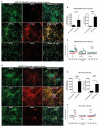Modelling Lyssavirus Infections in Human Stem Cell-Derived Neural Cultures
- PMID: 32218146
- PMCID: PMC7232326
- DOI: 10.3390/v12040359
Modelling Lyssavirus Infections in Human Stem Cell-Derived Neural Cultures
Abstract
Rabies is a zoonotic neurological infection caused by lyssavirus that continues to result in devastating loss of human life. Many aspects of rabies pathogenesis in human neurons are not well understood. Lack of appropriate ex-vivo models for studying rabies infection in human neurons has contributed to this knowledge gap. In this study, we utilize advances in stem cell technology to characterize rabies infection in human stem cell-derived neurons. We show key cellular features of rabies infection in our human neural cultures, including upregulation of inflammatory chemokines, lack of neuronal apoptosis, and axonal transmission of viruses in neuronal networks. In addition, we highlight specific differences in cellular pathogenesis between laboratory-adapted and field strain lyssavirus. This study therefore defines the first stem cell-derived ex-vivo model system to study rabies pathogenesis in human neurons. This new model system demonstrates the potential for enabling an increased understanding of molecular mechanisms in human rabies, which could lead to improved control methods.
Keywords: chemokine and cytokine response; ex-vivo models; lyssavirus; neuronal apoptosis; rabies; stem cell-derived neurons; trans-synaptic axonal trafficking; viral pathogenesis.
Conflict of interest statement
The authors declare no conflict of interest.
Figures





References
-
- Troupin C., Dacheux L., Tanguy M., Sabeta C., Blanc H., Bouchier C., Vignuzzi M., Duchene S., Holmes E.C., Bourhy H. Large-scale phylogenomic analysis reveals the complex evolutionary history of rabies virus in multiple carnivore hosts. Plos Pathog. 2016;12:e1006041. doi: 10.1371/journal.ppat.1006041. - DOI - PMC - PubMed
Publication types
MeSH terms
Substances
LinkOut - more resources
Full Text Sources
Medical
Miscellaneous

